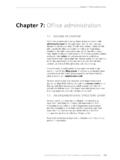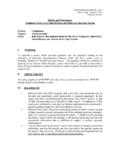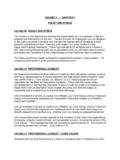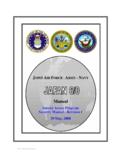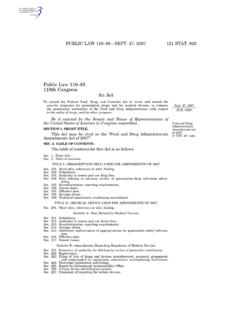Transcription of Chapter 7: Office administration - Progressio
1 _____Chapter 7: Office administrationCapacity building for local NGOs: A guidance manual for good practice179 Chapter 7: Office OUTLINE OF CHAPTERThis Chapter provides advice and guidance on how to ensure a solidadministrative basefor the organisation. Without this, chaos anddisorder are almost guaranteed. In addition to communicating with thepublic outside the Office (see Chapter 8: Publicity and fundraising),members of the public communicate directly with the Office throughvisits, telephone calls and correspondence. The Chapter provides guidanceon how to make visitors feel welcome and how to establish anappointments system and a telephone message system.
2 It gives some tipsfor sending and receiving letters, and advice on how staff can bestcommunicate internally through memos and Office of the most important administrative systems to establish andmaintain is an efficient filing system. The Chapter gives detailed adviceabout how to do this. It also provides guidelines on what to look forwhen undertaking an administrative organisations collect paper resources in the shape of books anddocuments. Many NGOs will want to establish a resource centrewherethey can keep these resources in an orderly manner and make themaccessible to staff and others. The Chapter gives detailed advice on howto manage paper resources and a resource centre AN ORGANISATIONAL STRUCTURE CHARTAn organisational structure chart is a diagram that represents anorganisation, identifying its employees and departments and theirrelationships to each other.
3 Chapter 2 (Organisational governance)provides an example of a structure chart for a governing body. Someorganisations will want to develop a similar chart to show officearrangements and lines of authority and for developing an organisational structure chart include the sixpoints in the box 7: Office administration _____180 Capacity building for local NGOs: A guidance manual for good practice It helps to involve staff when developing the chart so that theyunderstand the organisation s lines of authority and decision a chart has been developed the governing body should approve good organisational structure chart is well defined so that work isdelegated and shared and lines of authority, responsibility, and reportingrelationships are clear.
4 An organisational structure chart should beadapted to the context, particular goals, and habits of teamwork in thespecific organisation. There is no best structure: the best structure for oneNGO may be very different from the best one for questions in the box below may be useful when discussing thestructure of the organisation. Subsequent boxes give advice on writing upa :SOME KEY QUESTIONS ABOUT STRUCTURE What rules are there for the discussion of issues and decisionmaking? What kind of membership policy is needed? What role will different individuals (staff, partner organisations) playin decision making? Who is involved in what decisions, and how?
5 How will decision making be structured in the organisation? Whatkind of hierachy or system will there be? What type of organisational structure can best help achieve theorganisation s goals and mission? How can the vision and mission statement be implemented throughthe organisational structure? RELEVANCE OF AN ORGANISATIONAL STRUCTURE CHART It clarifies the lines of authority and how work is shared within theorganisation. Employees feel part of the NGO when they see themselves on thechart. It shows outsiders how the NGO is structured and its main areas ofwork. It shows the different departments and the number of staff. It makes the delegation of responsibilities easier.
6 A good structure should help the NGO reach its objectives. _____Chapter 7: Office administrationCapacity building for local NGOs: A guidance manual for good practice181 EXERCISE:WRITING UP A CHARTC onsider what information an organisational structure chart couldcontain. It may include some or all of the following: the name of the organisation the date the chart was compiled the lines of authority within the organisation the names of departments the names of projects employees names, job titles and possibly : ORGANISATIONAL STRUCTURE CHARTSOnce the chart has been drawn up, check for the following: consistency:include all names and/or job titles.
7 Clarity:distinguish job titles from departments or sub-teams clearly. completeness:do not forget the organisation s members,volunteers, and part-time staff. update: as and when necessary, and decide who should beresponsible for doing this. place: think about where to place the chart (eg as a poster inreception).See Appendix 1 for an example of an organisational structure Office COMMUNICATIONS People outside the organisation communicate with the Office in threemain ways: They visit the Office . They telephone the Office . They write a letter (or send an email) to the section present some tips for the efficient management of thesethree types of to manage Office visitorsThe very nature of NGO work means that the Office should beaccessible, particularly to the beneficiaries and client groups.
8 Membersof the public will also want to visit the Office to find out more about theorganisation s work and to offer or seek assistance. Sometimesgovernment officials or representatives of other NGOs or internationalfunding agencies will also come to the Office for meetings. It is importantthat their first impressionsof the Office are 7: Office administration _____182 Capacity building for local NGOs: A guidance manual for good practice TIPS FOR MAKING VISITORS FEEL WELCOME Install a signboard outside the Office with the organisation s name, Office hours and contact details, so that visitors will know what theorganisation is and how to make contact with it. Some offices withfewer staff distinguish between Office hours and visiting hours , toreduce the demands that too many visitors can place on staff.
9 Make a sign giving directions to the main entrance and receptionarea. Label the offices of individuals with the person s name and job titleso that visitors can find the Office that reception staff direct them to. Set up a reception area with at least two chairs and a small table. Put the organisation s brochure and annual report on the table forvisitors to read while they are waiting. Keep an appointments book that shows when visitors are possible make appointments for visitors to discourageunexpected visits. Design any noticeboards (vehicle control board, meeting board, etc.)nicely so that they make the Office look more attractive. You may want to hang a display board showing the organisation scurrent activities.
10 This could include photos (with captions) of staffor partners at work, workshops they have attended, and visitors tothe Office . Display the organisational structure chart, mission statement andstrategic plan if you have them. Make sure that the reception area, however small it may be, isalways clean and tidy. Take any steps necessary to make the Office accessible to disabledpeople. To ensure that the daily work of staff at the Office is not endlesslyinterrupted by unanticipated visitors, it is advisable to establish anappointments system. Of course visitors will come to the officeunexpectedly from time to time, but an appointments system will ensurethat most visits are planned in advance for the benefit of both staff andthe visitors themselves.
